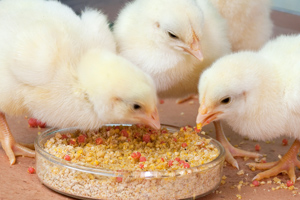New vaccine delivery system for newborn chicks developed

An alternate vaccine delivery system for newborn chicks has been developed by US Department of Agriculture (USDA) scientists to improve vaccination against intestinal diseases like coccidiosis.
A common and costly poultry disease, coccidiosis is caused by tiny, single-celled parasites that belong to the genus Eimeria. Infected birds spread disease by shedding oocysts, the egglike stage of the parasite. The infected birds are slower to gain weight and grow, and sometimes die.
Traditional poultry vaccine methods involve vaccinating chicks in trays on a conveyor with an electronic sprayer. However, some chicks may be missed by these methods and consequently have little defense against diseases.
The alternate system, developed by scientists at the Agricultural Research Service (ARS) Henry A. Wallace Beltsville Agricultural Research Center (BARC) in Beltsville, Md., and Southwest Research Institute (SwRI) in San Antonio, Texas, involves putting low doses of live Eimeria oocysts inside gelatin beads, which are fed to birds.
Microbiologist Mark Jenkins and zoologist Ray Fetterer, in BARC’s Animal Parasitic Diseases Laboratory, examined the gelatin bead vaccine effectiveness in chicks of layer hens and broilers. One-day-old chicks were immunised by ingesting gelatin beads or with a hand-held sprayer. The group that swallowed the gelatin beads had a greater vaccine uptake than the group that received the vaccine in spray form, and was better protected against coccidiosis.
In another experiment, chicks were reared similarly to birds in a poultry house, vaccinated with the gelatin beads and later given a dose of Eimeria oocysts. The vaccine-bead-fed chicks had greater weight gains than an unvaccinated group and were more capable of converting feed into body mass.
ARS and SwRI scientists have filed a patent application for this research and are working on a gelatin bead vaccine delivery device for commercial poultry houses.
More about this research can be found in the January 2014 issue of Agricultural Research magazine
Source: USDA











